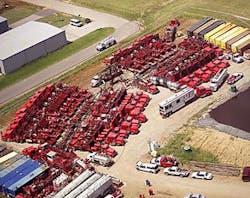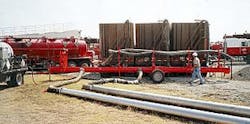In August 2004, Beeville-based Dan A. Hughes Co. pumped a large hydraulic fracture job in the prolific Barnett shale of North Texas. The Barnett is a tight shale that is the source for the largest gas field in Texas. It consists of an upper section and a thicker lower section with five lobes: A, B, C, D, and E.
Barnett shale wells were historically drilled vertically, but now it's common to drill laterally, with the kickoff at the top of the upper Barnett section, says Lee Roy Hoskins, a petroleum engineer at Dan A. Hughes.
Hughes drilled a horizontal well (City of Denton Airport No. 2H) in Denton County, Tex., using San Antonio-based Pioneer Drilling Co. Inc. The company's Rig No. 23 drilled to 11,000 ft in 34 days, including an 1,800 ft lateral section, and reached the lower Barnett shale target at about 8,700 ft TVD. The well was completed with 7-in. diameter, 29 lb/ft, P-110 casing and 23/8-in. tubing.
The frac was designed by Jeff Ilseng (Hughes's operations manager), Hoskins, Lee Matthews (consultant), and Dave Pronger (Halliburton Corp.). A total volume of 130,000 bbl was pumped into the E-lobe of the lower Barnett in three stages on 3 consecutive days. Each stage was pumped at a rate of 200 bbl/min at an anticipated wellhead tubing pressure (WHTP) of about 8,000 psi. The maximum pressure observed during this job was about 8,400 psi and the maximum rate achieved was 212 bbl/min.
null
Hoskins told OGJ that it was one of the largest assemblies of hydraulic horsepower (hhp) capability for a Barnett shale frac, with a pump rate about 30-40% higher than frac jobs on similar wells.
Halliburton Corp. assembled trucks with the capability to deliver 61,000 hhp in order to maintain the necessary delivery rate. This was delivered by 34 pump trucks of two types: the older "twin" trucks were each capable of providing 800 hhp, and the new HT-3,000 prototype trucks, manufactured in Duncan, Okla., supplied 3,000 hhp each.
The pump trucks were brought in from Duncan, Okla.; Jacksboro, Laredo, and Kilgore, Tex. Other trucks on site included four blenders, three mountain movers (for sand), four chemical transfer trucks, and one acid transport truck.
Frac fluid system
The fresh water for the frac came from a 150,000-bbl pit constructed more than 1 mile away, transported through 10-in. aluminum lines provided by H2O Transfer Services Inc., Montague, Tex., a system used by operator Hughes on other frac jobs.
Jerry Mueller (Lonesome Dove Transport & FTR LLC, Stamford, Tex.) supplied 20 frac tanks. Hoskins pointed out that in the past, large frac jobs would have required up to 150 frac tanks, arranged two rows deep in a large square flanking the drill site, but the new aluminum lines streamlined the operation.
H2O Transfer provides two or three trailer-mounted centrifugal pumps (depending on the rate required) with their suction lines placed in the frac pit. The frac pit was built at the highest point in the lease block, so that the water was always pumped downhill. Pumping the water uphill over that distance would have required installation of booster pumps along the lines.
At the rig site, a manifold system routes the water into different frac tanks, at up to 200 bbl/min (Fig. 2).
H2O Transfer Services adapted the aluminum line technique from the irrigation business.
The 10-in. diameter aluminum pipe is very light (around 50 lb/joint) and metal circle lock bands connect the 40-ft joints. The bands have "quick latches," or buckles similar to those on a ski boot or musical instrument case. The latches enable the pipe to be disassembled, moved, and reassembled very quickly, with a minimum labor force.
Donald Fenoglio, owner of H2O Transfer, designed "skid" type road crossings that enable the pipe to be sheltered in steel tubing while vehicles drive over the skid. He told OGJ that each skid is carried on a gooseneck trailer behind a 1-ton truck, and can be jackknifed into place in only a few minutes. All public road crossings also require city or county permits.
Fenoglio said his company has worked with 43 different operators in the Barnett shale in the past 2 years, and it has enough pipe on hand (100,000 ft) to service up to five frac jobs simultaneously.
The water line crew members work with two-way radios on the same frequency as the frac crew for safety coordination so that they are not over-boosting or under-boosting flow to the tanks and know when to begin and shut down.
Hoskins said that on another job they laid 27,000 ft of the aluminum line in 2 days and had it disassembled in 1 day after the frac job (consisting of three lines running to a location 9,000 ft away, almost 2 miles).
Proppant, tracers, acid
Halliburton pumped about 837,000 lb of sand, consisting of 40/70 Ottawa (about 70%, ramped 0.1-0.35 ppg) and 20/40 Ottawa (about 30%, ramped 0.15-1.0 ppg). This is a relatively low proppant concentration but typical for the work being done in the area, Hoskins said. He also noted that sand shortages in North Texas cause them sometimes to substitute 30/50 for the 40/70 fraction, with no discernible difference in results.
The sand was carried with slickwater (biocide-treated fresh water; 0.835 density). The fluid also contained Halliburton's FR-26 friction reducer. Low-viscosity frac fluids with little or no gel are easier to pump into narrow fractures and leave less residue, requiring less cleanup and making them less likely to reduce permeability or impede flow.
Before the frac was pumped, the proppant was tagged with radioactive tracers. The operator hired Kilgore, Tex.-based ProTechnics for tracing, and Computalog, a wholly owned subsidiary of Precision Drilling Corp., for wireline logging.
The aluminum transfer lines connect to a manifold at the drill site, which distributes the water to the frac tanks (Fig. 2; photo from H2O Transfer Services Inc.).
ProTechnics, a division of Amsterdam's Core Laboratories NV, ran radioactive tracer (gamma ray) logs with its SpectraScan completion-imaging tool. After drilling out the plugs and setting 23/8-in. tubing, the tool was pumped through the tubing on a wireline. The tracer logging work cost about $5,000/stage in addition to the cost of the wireline company services.
The operator pumped 15% hydrochloric acid (HCl) supplied by Halliburton. It was staged in during the breakdown phase of the frac job. Hoskins noted a significant drop in pressure with each acid slug.
Recovery, production
The well flowed back about 25,000 bbl frac fluid (about 15% of the loadwater) to the tank in the 6 days following the fracture stimulation work. The production went to sales at more than 4 MMcfd in mid-September 2004, dropping to about 2.5 MMcfd in early February 2005.
Cement?
The operator compared the results of fracturing an uncemented lateral (this well) with a nearby, cemented lateral. Hoskins told OGJ that fracturing the cemented lateral produced better results, in terms of initial production rates (5 MMcfd vs. 4.4 MMcfd). He thinks cementing provides better control over fracture initiation and growth and helps to reduce cross-flow behind pipe.
Hoskins noted that with cemented wells, it's possible to use a two-stage frac, rather than three-stage, saving up to $500,000. Cemented laterals also appear to require lower pressure to frac; there is another significant (30-40%) cost savings in running at 160 bbl/min instead of 200 bbl/min.
Other Barnett shale operators, notably Devon Energy Corp. and Cleburne, Tex.-based Hallwood Energy Corp., have run similar studies and found that cementing laterals produced better results, said Hoskins.
Tubing advance
One of the latest cost-saving technologies used in the Barnett shale is e-coil tubing. This has been available in the field in North Texas since 2003, provided by Schlumberger Ltd. and Denton, Tex.-based Procoil Coiled Tubing Services, a subsidiary of Parchman Energy Group Inc.
The tubing has an embedded electric line, facilitating tubing-conveyed electric perforating guns and setting tools. This saves time and money because workers can set plugs without having to lease a workover rig and snubbing unit. Hoskins pointed out that it also allows the operator to unload the well days earlier, removing potentially damaging chemical water from the formation.
E-coil is a precursor to smart composite tubing technologies incorporating fiber optics.
Barnett play
Dan A. Hughes Co. entered the Barnett play in 2003 and drilled 10 wells through 2004. The company spudded its 11th well in January 2005, which includes a 3,500-ft lateral section.
The company has several planned locations ahead, exploring its current acreage, and is interested in expanding its position. Hoskins said "lease costs are becoming inflated," having increased considerably since 2003.
Hughes thinks current drilling activity would continue as long as market prices stay at more than $5/Mcf. If prices dropped to $4/Mcf or less, the company expects activity to slow considerably because of the high cost of drilling and stimulation services.
The cost of a Barnett well depends on the length of the lateral section but ranges $1.7-2.5 million for drilling, casing, and stimulation services.
Dan A. Hughes Co. is most active in South Texas (50%), but it also busy in the Barnett shale play (25%), and has operations in Colombia and Australia.


